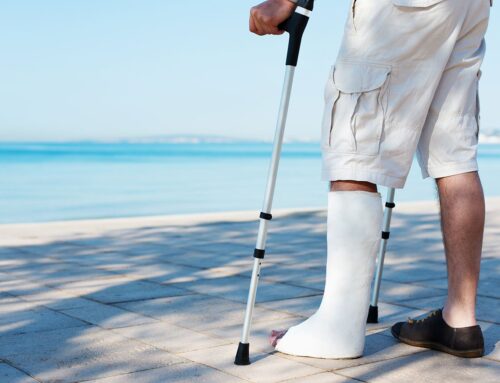You’ve done everything right. You’ve rested, you’ve kept your cast dry, and you’ve followed your doctor’s orders to the letter.
But weeks, or even months, after your injury, you’re still not back on your feet.
Your doctor tells you that your bone is showing a “delayed union,” or perhaps even more concerning, “a non-union fracture.”
Those words can sound pretty scary. You might feel frustrated and worried or wonder if your bone will ever fully heal. You might be dreading the possibility of another surgery in your future.

Take a deep breath: while these diagnoses mean your fracture needs more help to heal, you're not out of options. Modern therapies like LIPUS can restart stalled fracture healing and help delayed fractures get back on track.
Quick Takeaways:
- A delayed union fracture means your bone is healing, but slower than expected; a non-union fracture means healing has stopped altogether.
- There are a few factors that can affect bone healing, including poor blood supply, nutrition, lifestyle habits (like smoking), the severity of the injury, and underlying health conditions.
- LIPUS (Low-Intensity Pulsed Ultrasound) is a painless, non-invasive treatment that uses sound waves to stimulate bone repair and help restart the healing process.
- Studies show LIPUS can speed up healing in fresh fractures by up to 38% and achieve success rates of up to 86% for non-union fractures.
When Good Bones Heal Slowly: Your Body’s Timeline
When you break a bone, your body launches an amazing, multi-stage repair mission. You might compare it to a construction crew arriving on site.
First, inflammation brings in the cleanup crew to manage the immediate damage. Then, specialized cells called osteoblasts get to work building a soft, flexible bridge of cartilage known as a callus. Over time, this callus hardens into what eventually becomes a new, strong bone.
This entire process can take several months. But just as you might have experienced if you’ve undertaken any construction project, sometimes, things don’t go according to plan.
What is a Delayed Union Fracture?
A delayed union fracture is exactly what it sounds like: your bone is healing, but it’s taking longer than expected. Your bone-building crew is working at half-speed. They’re still on the job, and the structure is coming together, but the project is running behind schedule.
Doctors are likely to diagnose a delayed union when a fracture hasn’t shown significant signs of mending after about three to six months.
This can happen for several reasons, including poor blood supply to the fracture site, the severity of the initial break, or underlying health conditions such as diabetes.
What is a Non-Union Fracture?
With a non-union fracture, the healing process has stalled out completely. To continue the construction analogy, the crew has packed up and gone home, leaving the job unfinished.
After 9+ months with no progress, your doctor will likely classify the injury as a non-union fracture. At this point, the bone fragments have completely stopped trying to join together.
This can happen if the gap between the broken ends of the bone is too large, if there’s an infection, or if the fracture isn’t held stable enough with a cast or hardware.
While a non-union can be painful and limit your mobility, making you feel stuck, the good news is: you’re not.
Why Does Bone Healing Slow Down or Stop?
Your body is a powerful healing machine, but sometimes, it runs into challenges too big for it to handle on its own. There are several factors that can interfere with bone repair and lead to delayed bone healing:
- Blood Supply: Healing requires a steady flow of oxygen and nutrients, all delivered by your blood. Bones with a limited blood supply, like the scaphoid in your wrist or the talus in your ankle, are naturally more prone to healing problems.
- Nutrition: Your bone-building cells need raw materials. A diet lacking in calcium, vitamin D, and protein can shortchange your body of the essential building blocks it needs for strong repairs.
- Lifestyle Habits: Smoking is a major obstacle to bone healing, as are caffeine and alcohol. Nicotine constricts blood vessels, choking off the vital blood flow your fracture needs. Studies have shown that the non-union rate for some fractures can be significantly higher in smokers.
- The Injury Itself: A severe break, like a bone shattered into multiple pieces or an open fracture that broke the skin, creates a much bigger repair job. These complex injuries have a higher risk of becoming a non-union fracture.
- Underlying Conditions: Health issues like diabetes, vascular disease, osteoporosis, or hormonal imbalances can disrupt your body's ability to heal effectively.
Jumpstarting Healing Without Surgery: The Role of LIPUS
For years, the frontline solution for a non-union fracture was surgery. This often involves things like bone grafts, internal plates, and screws. While surgery can indeed be effective, it’s also invasive and comes with its own extended recovery period.
Thankfully, you now have another tool on your side. The Melmak LIPUS (Low-Intensity Pulsed Ultrasound) device is a clinically-proven, FDA-approved, and Health Canada-licensed therapy that helps restart your body’s natural healing engine. It’s safe, painless, and non-invasive, and most importantly, it’s a treatment you can use right at home.
How Does LIPUS Treatment Work?
The science behind LIPUS is fascinating. The device sends low-intensity, high-frequency sound waves through your skin and soft tissue, directly to the fracture site. You won’t feel a thing, but on the cellular level, that construction crew is kicking into high gear.
These gentle pulses of energy stimulate the cells responsible for bone repair. They encourage your body to increase the production of growth factors, improve blood flow to the area, and accelerate the process of turning that soft callus into hard, solid bone.
A LIPUS treatment session is simple and takes just 20 minutes of your passive time each day. You place the device’s small transducer over your fracture, press a button, and let it get to work while you read a book or watch TV.
LIPUS treatment is backed by decades of science and supported by extensive clinical research. For fresh fractures, LIPUS has been shown to accelerate healing of certain bones by up to 38%, and for non-unions, up to 87%. Thousands of patients have avoided surgery as a result.
This trusted therapy is recommended by orthopedic surgeons and doctors across Canada for both new injuries and stubborn, slow-healing breaks alike. Your doctor may even recommend LIPUS as an early intervention for a fresh fracture if you have any risk factors (as described above) for a delayed union.
Take Control of Slow-Healing Fractures
Hearing that your fracture isn’t healing on schedule can be disheartening, to say the least, but it’s not a final verdict. Instead, consider it an invitation to take a more active role in your recovery.
Whether your healing has slowed or ground completely to a halt, LIPUS offers a safe and proven way to get things moving again. It will help your body do what it does best: heal itself.
If you’re struggling with a slow-to-heal fracture, don’t lose hope. Talk to the Fracture Healing team about whether the Melmak LIPUS device is the right choice for you. It could be the key to finally closing the gap, rebuilding your bone, and getting you back to the activities you love.





